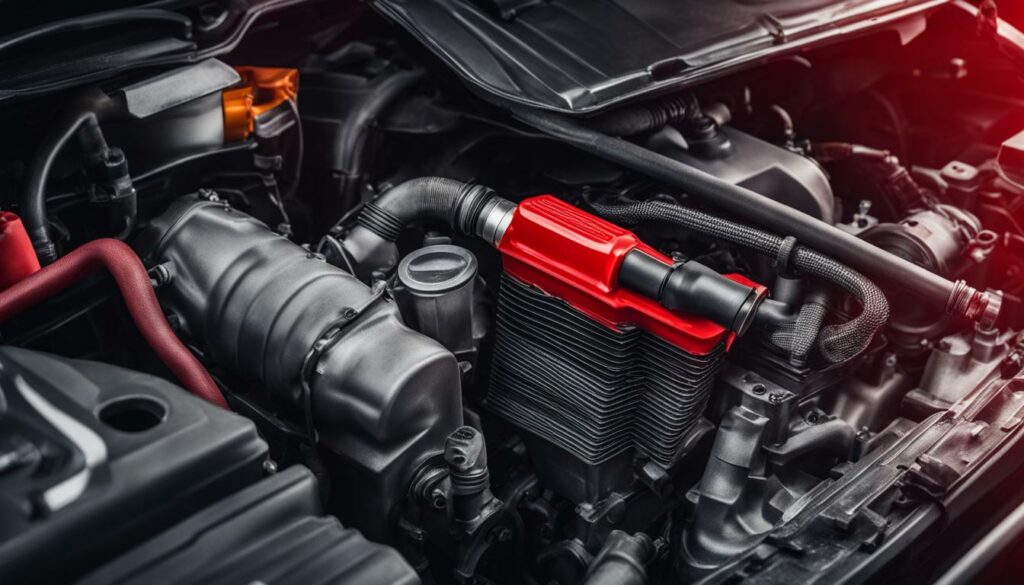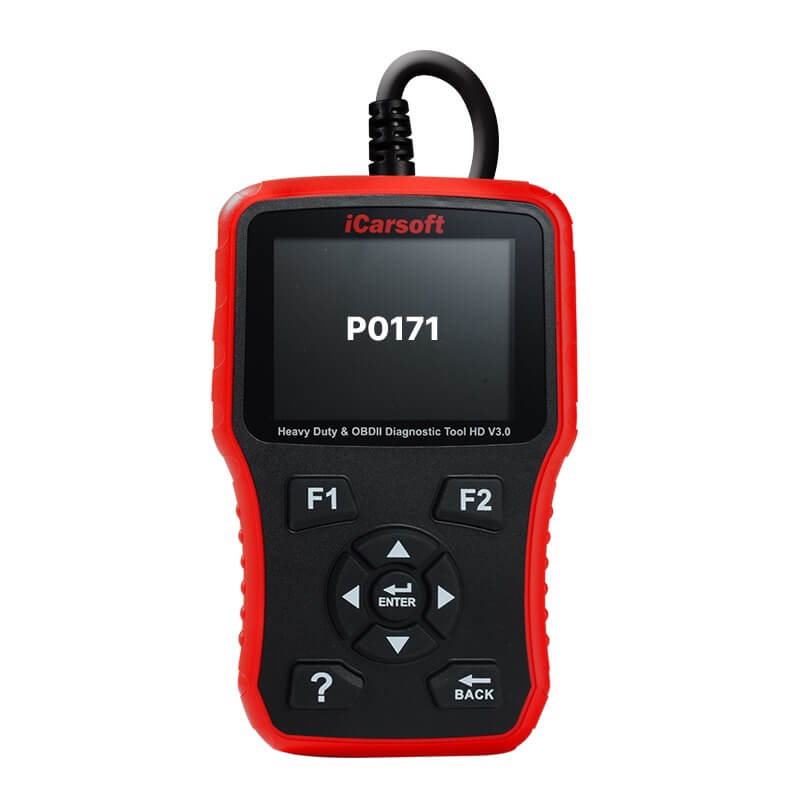P0171 – Fuel Trim System Lean
POSTED IN pcodes
Welcome to our article on the P0171 code, also known as the Fuel Trim System Lean. If you’ve encountered this engine code, it’s important to understand what it means and how it can affect your vehicle’s performance. The P0171 code indicates that the powertrain control module (PCM) has detected a lean air-to-fuel ratio in the engine.
So, what exactly does a “lean condition” mean? Essentially, it signifies that there is too much air and not enough fuel entering the combustion chamber. This imbalance in the fuel mixture can lead to a variety of issues, including reduced power, misfires, and rough idling.
The PCM relies on signals from oxygen sensors to adjust the air and fuel mixture. When the predetermined range falls out of line, it triggers the P0171 code. In response, the PCM initiates a positive fuel trim to increase the amount of fuel being injected into the engine.
Diagnosing and troubleshooting the P0171 code can be challenging, but by understanding its symptoms and possible causes, you can effectively address the issue. It’s important to address the code promptly to prevent further damage and maintain optimal engine performance.
In the following sections, we will discuss the symptoms, causes, diagnosis, troubleshooting, and repair steps for the P0171 code. We’ll provide you with the information you need to understand and resolve this issue, ensuring your vehicle runs smoothly and efficiently.
Buy tested tuning file for Adblue / EGR / DPF / Adblue off now!
Key Takeaways:
- The P0171 code indicates a lean air-to-fuel ratio in the engine.
- Symptoms include loss of power, misfires, and rough idling.
- Possible causes include vacuum leaks, malfunctioning mass air flow sensors, and a clogged fuel filter.
- Diagnosing the P0171 code may require professional assistance and various tests.
- Troubleshooting involves identifying the specific component or circuit causing the lean condition.
Symptoms of P0171 – Fuel Trim System Lean
When your vehicle’s onboard diagnostic system detects a P0171 code, it indicates a fuel trim system lean condition. This means that there is an imbalance in the air-to-fuel mixture entering the combustion chamber, resulting in a lean mixture. Understanding the symptoms associated with P0171 can help you identify and address this issue promptly.
Common Symptoms
- Loss of Power: You may experience a significant decrease in engine power when driving.
- Misfires: The engine may misfire or stumble, causing a rough and uneven running condition.
- Rough Idling: Your vehicle may idle roughly, with fluctuations in engine speed and noticeable vibrations.
In addition to these symptoms, it is common for the check engine light to illuminate when the P0171 code is triggered. This warning light serves as an indication that a potential issue exists within the fuel trim system. Ignoring these symptoms can lead to further engine damage and should be avoided.
To provide a visual representation of the symptoms of P0171, refer to the table below:
| Symptoms | Description |
|---|---|
| Loss of Power | Significant decrease in engine power |
| Misfires | Engine stumbles and runs unevenly |
| Rough Idling | Unsmooth idle with fluctuations and vibrations |
Causes of P0171 – Fuel Trim System Lean
In order to effectively address the P0171 code, it’s crucial to understand the underlying causes of a fuel trim system lean condition. Several factors can contribute to this issue, including:
- Vacuum leaks
- Malfunctioning mass air flow sensors
- Clogged fuel filter
These common culprits can disrupt the delicate balance between air and fuel, resulting in an insufficient fuel mixture. Let’s take a closer look at each of these causes:
- Vacuum leaks: When there are leaks in the vacuum system, unmetered air can enter the engine, causing a lean condition. Common sources of vacuum leaks include cracked or disconnected vacuum hoses, intake manifold gasket leaks, or a faulty PCV valve.
- Malfunctioning mass air flow sensors: Mass air flow (MAF) sensors measure the amount of air entering the engine, allowing the PCM to adjust the fuel injection accordingly. A malfunctioning or contaminated MAF sensor can inaccurately measure the air intake, leading to a lean fuel trim condition.
- Clogged fuel filter: The fuel filter plays a critical role in removing impurities from the fuel before it reaches the engine. Over time, the filter can become clogged with debris, restricting the fuel flow and causing a lean mixture.
Identifying these potential causes is the first step in diagnosing and resolving a P0171 code. By addressing vacuum leaks, testing the functionality of the MAF sensor, and checking the condition of the fuel filter, you can effectively rectify the fuel trim system lean condition.

Diagnosing P0171 – Fuel Trim System Lean
Diagnosing a P0171 code can be challenging, especially if you’re not familiar with automotive repairs. While it’s generally recommended to seek professional assistance for an accurate diagnosis, there are a few steps you can take on your own to identify potential issues.
- Check the wiring and sensors: Inspect the wiring harness and connectors for any signs of damage or corrosion. Faulty wiring or sensor connections can affect the fuel trim system and trigger the P0171 code.
- Perform vacuum tests: A vacuum leak can cause a lean condition in the engine. Use a vacuum gauge to check for any leaks in the intake manifold, hoses, or vacuum lines. Fixing a vacuum leak can often resolve the P0171 code.
- Use a digital multimeter: A digital multimeter is a handy tool for diagnosing electrical issues. You can use it to measure the voltage and resistance of various components such as the oxygen sensors, mass air flow sensor, and fuel injectors. Comparing the readings to the manufacturer’s specifications can help identify faulty parts.
If the above steps don’t pinpoint the exact cause of the P0171 code, it’s recommended to consult a professional technician who has access to specialized diagnostic equipment and software. They will be able to perform more advanced tests and accurately diagnose the issue.
Remember, diagnosing a P0171 code requires technical expertise, so don’t hesitate to seek professional help if you’re unsure about performing these diagnostic steps.
Quote:
If left unresolved, a P0171 code can lead to long-term engine damage and decreased fuel efficiency. It’s crucial to address this issue promptly to avoid further complications.
By following these diagnostic procedures, you can gain a better understanding of the underlying cause of the P0171 code. This information will help you communicate effectively with your mechanic and facilitate a more efficient repair process.
To visually reinforce the diagnostic process, here’s a table summarizing the key diagnostic steps:
| Diagnostic Steps | Description |
|---|---|
| 1. Check wiring and sensors | Inspect wiring harness and connectors for damage or corrosion. Ensure proper sensor connections. |
| 2. Perform vacuum tests | Use a vacuum gauge to check for any leaks in the intake manifold, hoses, or vacuum lines. |
| 3. Use a digital multimeter | Measure voltage and resistance of various components, such as oxygen sensors, mass air flow sensor, and fuel injectors. |
With these diagnostic tools and techniques, you’re well-equipped to identify the root cause of the P0171 code in your vehicle. Remember, accurate diagnosis is the key to effective repairs and ensuring optimal engine performance.
Troubleshooting P0171 – Fuel Trim System Lean
When faced with a P0171 code indicating a fuel trim system lean condition, it becomes crucial to identify the specific component or circuit responsible for the issue. Accurate diagnosis is key to prevent further damage to your engine. Here are some steps to help you troubleshoot the problem:
- Consult Repair Manuals: Begin by referring to the repair manuals specific to your vehicle model. These manuals provide valuable information on the fuel system components, their location, and how they function.
- Seek Professional Guidance: If you find it challenging to troubleshoot the P0171 code on your own, don’t hesitate to seek assistance from a qualified automotive technician. They have the knowledge and experience to navigate complex diagnostic procedures.
- Inspect Vacuum Lines: Check your vehicle’s vacuum lines for any signs of leaks or damage. A leak in the vacuum system can disrupt the air and fuel mixture, leading to a lean condition. Ensure all connections are secure and that there are no cracks or holes in the lines.
- Examine Mass Air Flow (MAF) Sensor: Inspect the MAF sensor for contamination or damage. Dirt, debris, or a faulty sensor can affect the accuracy of the air intake measurement, resulting in incorrect fuel trim calculations. Clean or replace the MAF sensor as necessary.
- Check Fuel System: Verify the condition of your fuel system components, including the fuel filter, fuel injectors, and fuel pressure regulator. A clogged fuel filter or malfunctioning injectors can lead to fuel delivery issues, causing a lean condition. Replace any faulty components accordingly.
- Inspect Oxygen (O2) Sensors: Oxygen sensors play a critical role in providing feedback to the powertrain control module (PCM) about the air-to-fuel mixture. Ensure the O2 sensors are functioning correctly and within specifications. Faulty sensors may provide inaccurate readings and trigger the P0171 code.
- Perform Electrical Checks: It’s essential to examine the wiring and connections related to the fuel trim system. Look for any frayed wires, loose connections, or corroded terminals. Faulty electrical connections can disrupt the signals between the sensors and the PCM, leading to a lean condition. Repair or replace any damaged wiring as needed.
By carefully troubleshooting the P0171 code using these steps, you can identify the root cause of the problem and take appropriate measures to resolve it, ensuring the optimal performance and longevity of your engine.
Repairing P0171 – Fuel Trim System Lean
When dealing with a P0171 code, the repair process depends on identifying the specific component or circuit that is causing the lean condition. The following methods may be necessary to resolve the issue:
- Replacing sensors: Faulty oxygen sensors or mass air flow sensors can contribute to a lean mixture. Replacing these sensors can help restore the proper air and fuel ratio.
- Cleaning the throttle body: A dirty throttle body can restrict airflow, leading to a lean condition. Cleaning the throttle body using appropriate cleaning solutions can improve performance.
- Fixing vacuum leaks: Vacuum leaks can introduce excess air into the engine, contributing to a lean mixture. Identifying and addressing these leaks, such as damaged hoses or gaskets, is crucial for repairing a P0171 code.
- Addressing other issues: Depending on the specific circumstances, additional repairs may be necessary. These can include replacing fuel filters, checking fuel injectors, or inspecting the fuel pump for proper operation.
For accurate repairs, it is recommended to consult the factory repair information for your particular vehicle model. With the right knowledge and appropriate repairs, you can effectively resolve the P0171 code and restore the optimal functioning of your engine.

Other Notes about P0171 – Fuel Trim System Lean
When your vehicle’s onboard diagnostic system detects a P0171 code, it’s crucial not to ignore it. Ignoring this code can have negative consequences, including reduced fuel economy, poor performance, and potential engine damage. It’s important to address the issue promptly to avoid further complications.
One key aspect of resolving a P0171 code is following the recommended repair procedures for your specific vehicle model. Each vehicle may have unique specifications and requirements, and adhering to the manufacturer’s guidelines ensures that the repairs are done correctly. It may be helpful to consult your vehicle’s repair manual or seek professional assistance to ensure accurate repairs.
If you’re unsure about how to proceed or lack the necessary expertise, it’s always a good idea to consult a qualified mechanic. They have the knowledge and experience to diagnose and repair the underlying issues causing the P0171 code. Trusting experts will help you resolve the problem efficiently and effectively, ensuring optimal engine performance in the long run.
Conclusion
Dealing with the P0171 code, which indicates a fuel trim system lean condition, can be a challenging task. However, by familiarizing yourself with the symptoms, causes, diagnosis, troubleshooting, and repair steps, you can effectively address the issue and ensure optimal engine performance.
If you encounter the symptoms of a P0171 code, such as loss of power, misfires, or rough idling, it’s crucial to take prompt action. Ignoring the code can lead to reduced fuel economy and potential engine damage. Seek professional assistance if needed and use reliable repair resources to accurately diagnose and resolve the problem.
During the diagnosis process, checking wiring and sensors, performing vacuum tests, and using a digital multimeter to measure voltage and resistance can provide valuable insights. Once the specific component or circuit causing the lean condition is identified, appropriate repairs can be implemented. This may involve replacing sensors, addressing vacuum leaks, cleaning the throttle body, or conducting other necessary repairs according to the factory repair information for your vehicle.
In conclusion, understanding the P0171 code and its associated fuel trim system lean condition empowers you to address the issue effectively. By following the recommended diagnosis and repair procedures, seeking professional assistance when necessary, and utilizing reliable resources, you can resolve the P0171 code and maintain optimal engine performance.
FAQ
What is the P0171 code?
The P0171 code is the engine code that indicates a fuel trim system lean condition. It means that there is too much air and not enough fuel entering the combustion chamber.
What are the symptoms of a P0171 code?
Some common symptoms of a P0171 code include loss of power, misfires, rough idling, and the illumination of the check engine light.
What are the possible causes of a P0171 code?
The causes of a P0171 code can vary, but some possible culprits include vacuum leaks, malfunctioning mass air flow sensors, and a clogged fuel filter.
How do you diagnose a P0171 code?
Diagnosing a P0171 code can be challenging, but some steps you can take include checking the wiring and sensors, performing vacuum tests, and using a digital multimeter to measure voltage and resistance.
How do you troubleshoot a P0171 code?
Troubleshooting a P0171 code involves identifying the specific component or circuit that is causing the lean condition. This may require consulting repair manuals or seeking professional guidance.
How do you repair a P0171 code?
Repairing a P0171 code depends on the specific component or circuit that is faulty. It may involve replacing sensors, cleaning the throttle body, fixing vacuum leaks, or addressing other issues.
Are there any other important notes about the P0171 code?
It’s crucial not to ignore a P0171 code as it can lead to reduced fuel economy, poor performance, and potential engine damage. Promptly addressing the issue and following recommended repair procedures is essential.


